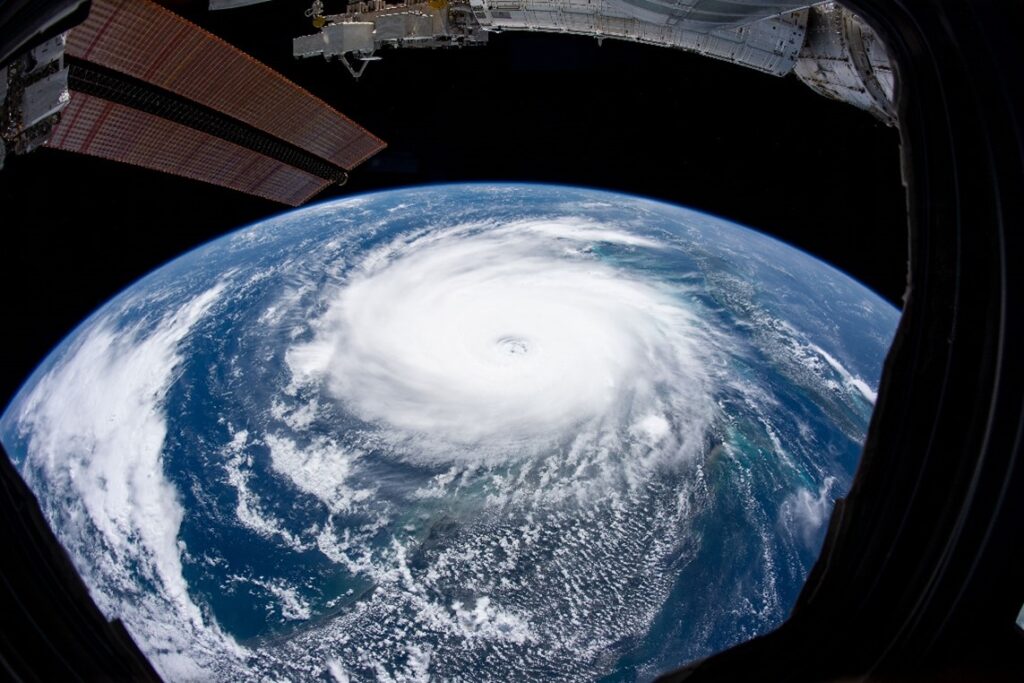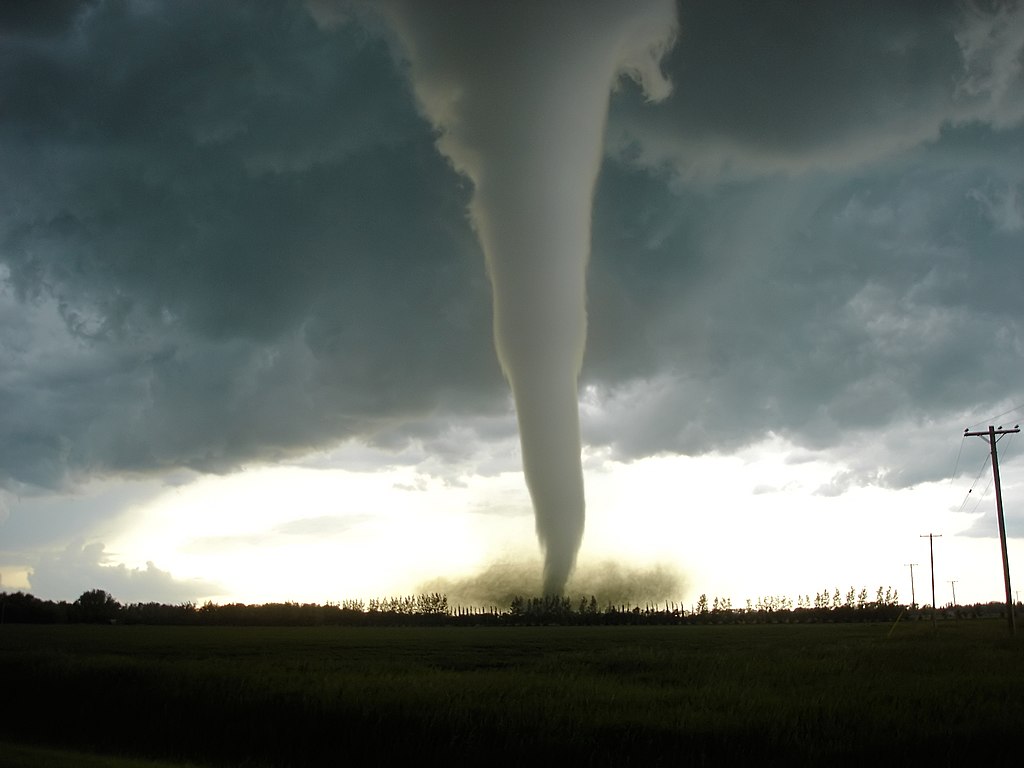AI helps to predict extreme winds and save lives

View of Hurricane Dorian on Sept. 2, 2019, from the International Space Station, as the storm churned over the northwestern Bahamas. NASA Johnson
“Hurricane Dorian was an extremely powerful and catastrophic Category 5 Atlantic hurricane, which became the most intense tropical cyclone on record to strike the Bahamas” (Wikipedia).
Wind is power.
From spreading seeds and pollen that grow forests and life to forming hurricanes and tornadoes that create enormous damage, the wind is a natural phenomenon that shapes our lives. Unsurprisingly, scientists have long worked to predict wind power in extreme weather events – which can be tricky. Now, the use of AI can potentially revolutionize the field of meteorology.
Over the past decades, we have seen an increase in the frequency (and both human and governmental costs) of extreme weather events around the world. In the US, the numbers of severe storms and tropical cyclones have never been so high, as can be seen in the graph below, from the National Oceanic and Atmospheric Administration (NOAA), official US government agency. However, this is not a pattern exclusive to the United States.
In a detailed investigation which is available online, Carbon Brief – a UK-based website specialized in climate science – analyzed more than 400 peer-reviewed studies about extreme weather events in many countries. They showed mounting evidence that human activity is increasing the risk of extreme weather worldly. So maybe we could say it has never been so urgent to better understand and predict these weather phenomena.

Timeline showing frequency and cost of severe weather events significantly affected by wind. Figure: NOAA.
Wind is the movement of air caused by the uneven heating of the Earth by the Sun.
The differences in atmospheric pressure generate winds that transport heat and moisture – as well as pollutants – across the globe. The dance between warmer and cooler air creates different types of wind and weather patterns.
Atmospheric pressure: “At the Equator, the sun warms the water and land more than it does the rest of the globe. Warm equatorial air rises higher into the atmosphere and migrates toward the poles. This is a low-pressure system. At the same time, cooler, denser air moves over Earth’s surface toward the Equator to replace the heated air. This is a high-pressure system. Winds generally blow from high-pressure areas to low-pressure areas” (National Geographic).
Wind affects climate, as many daily weather patterns depend on wind, and it also drives ocean surface currents around the world. Wind affects ecology, by moving dust and sand through great distances. It can erode landscapes, carry volcanic ash, and fertilize distant lands as it disperses plant seeds and increases the genetic diversity of plants. Wind is also an important source of clean energy, from pushing ships across the oceans and pumping water with windmills, to generating electricity that powers modern societies.
Devastating storms may happen as a consequence of wind travelling at different speeds and altitudes. For instance, a hurricane is a giant spiral-shaped tropical storm that forms as a high-pressure area twists around a low-pressure area that is warmer and calmer, called the “eye”. Hurricanes are rated from 1 to 5 in severity on the Saffir Simpson scale, and in a category-5 hurricane the wind can reach speeds up to 257 km/h (160 mph). Hurricanes can devastate coastal ecosystems and communities by producing giant waves that can reach 6 meters, or 20 feet, high. They can also generate tornadoes and heavy rains that lead to floods and landslides, devastating entire communities.
Tropical storm: “These same tropical storms are known as hurricanes in the Atlantic Ocean, cyclones in the northern Indian Ocean, and typhoons in the western Pacific Ocean” (National Geographic).
“A tornado, also called a twister, is a violently rotating funnel of air. Tornadoes can occur individually or in multiples, as two spinning vortexes of air rotating around each other”. (National Geographic).
Changing climate conditions have led to a growing number of extreme weather events around the world, increasing the frequency of severe storms.
The best defense against hurricanes and tornadoes is accurate forecasting and early warning, so people can get out of their way and into safety. This is difficult, as weather forecasting is notoriously difficult.
However, with recent advances in machine learning, scientists are now hopeful that the use of artificial intelligence (AI) will increase the accuracy of weather forecasts in a changing climate. With more accurate forecasting, countries can better prepare for these events, minimizing damage and potentially saving many lives.
“Machine learning (ML) is a type of artificial intelligence (AI) that allows software applications to become more accurate at predicting outcomes without being explicitly programmed to do so. Machine learning algorithms use historical data as input to predict new output values” (TechTarget).
“Over the last few decades, we have seen advances in technology increase the power and sophistication of computer models that underpin weather and climate science and services. Recent progress in these areas has brought the world to the cusp of potentially game-changing breakthroughs in weather and climate modeling. Data science and artificial intelligence have huge potential to drive forward new advances in weather and climate science to help make society better able to survive and thrive in a changing climate”, says Dr. Stephen Belcher, chief scientist at the UK national meteorological service (Met Office).
Since 2020, many governmental organizations have published strategies aimed at expanding the use of AI for weather and climate predictions, such as the National Oceanic and Atmospheric Administration (NOAA), in the US, and the European Centre for Medium-Range Weather Forecasts (ECMWF). In Europe, the European Weather Cloud is expected to play a significant role in the development of machine learning tools. In the UK, a recent report by the Met Office proposed a framework for machine learning and artificial intelligence in weather and climate science in the years to come.

Category 5 tornado as it approached Elie, Manitoba on Friday, June 22nd, 2007. Justin Hobson
“Extreme weather events (…) all highlight our vulnerability to natural climate variability in the present-day and are a forewarning of the increasing risks associated with climate change. The need for action on climate change is urgent; science and technology have a vital role to play in ensuring we can better understand and manage the key hazards in order to become climate resilient through both mitigation and adaption,” reads the Met report.
At Pennsylvania State University, researchers have created an AI algorithm to detect cloud formations that lead to storms. They analyzed more than 50,000 weather satellite images and successfully taught computers to automatically detect formations that may lead to severe weather, by using computer vision and machine learning. They reached nearly 100 percent accuracy identifying their main object of research, the comma-shaped clouds that often lead to severe weather events. Moreover, they managed to do that in under a minute. The AI also predicted extreme weather events. In that, it reached a success rate of about 64%, which might seem low, but is far better than established detection systems.
Many organizations are investing in AI for better forecasting.
At NASA’s Jet Propulsion Laboratory and Google’s DeepMind AI company, for instance, researchers are using machine learning to more accurately detect the intensification of storms into hurricanes and increase the accuracy of short-term weather forecasts. Another example is data analytics and technology company DTN, which is using AI for both storm and wildfire prediction, combining historic information, predictive models, and geographic data.
Weather forecasting often requires vast amounts of data, an advanced understanding of physics, and significant computational power. Powerful AI methods are more accurate, faster, and inexpensive since they can run on smaller computers. Thus, they may soon replace the expensive supercomputers that are often needed to process large amounts of data.
“Average costs associated with extreme weather events in the United States have increased steadily since 1980. These have costly impacts on cities’ basic services, infrastructure, housing, human livelihoods, and health. AI helps us to calculate that risk and can be used as a preventive measure,” said DTN vice president of weather operations, Renny Vandewege.
Unfortunately, many of the countries most affected by climate change do not have access to the level of technology and amount of investment needed to develop such tools. However, researchers are working on ways to reduce costs by building more efficient systems.
One example is ClimateAI, a climate risk and planning company that uses a specific technique. They look at coarse global weather forecasts, correct for errors, and then downscale the forecasts for local/regional scale, which generates more accurate local forecasts. By doing so, they can reduce costs and computing power, while increasing accuracy. Based on machine learning, their technique depends on neural networks, artificial circuits designed to work like neurons in the human brain.

Effect of wind on trees. Yohan euan o4
When we think about wind, we can make the mistake of underestimating its power.
We may think of how the wind can gently blow an old leaf off a tree in autumn. But just as the sea can generate both a gentle wave and a tsunami, the movement of air can take alarmingly different proportions from one place to the next. It might not be just a coincidence that many polytheistic religions have one or more wind gods. It may seem ironic that our best hope of predicting and preparing for extreme weather is technology developed by a modern lifestyle that has caused the damage of climate change. Maybe, despite our technological advancement, we still have some lessons to learn from societies that honored – and prayed for – the gods of nature.



